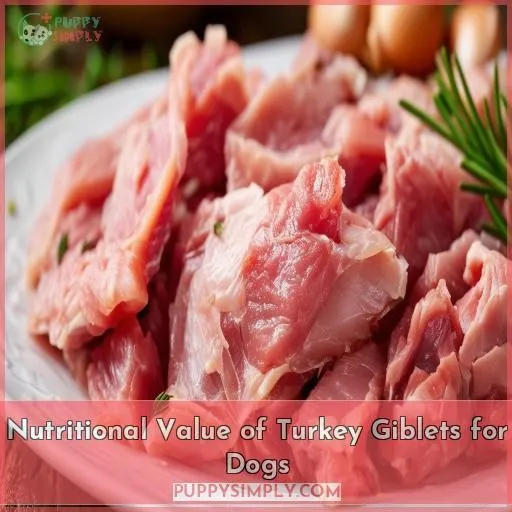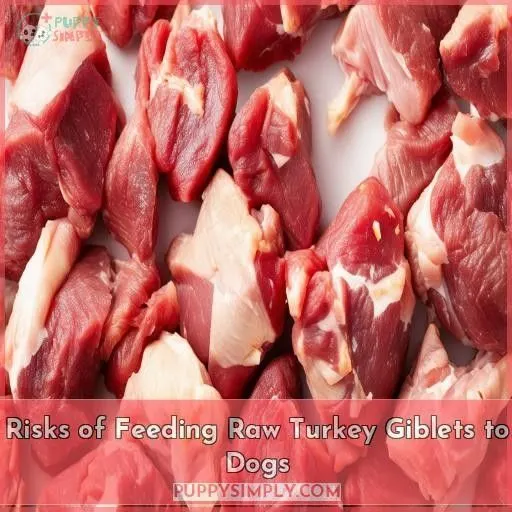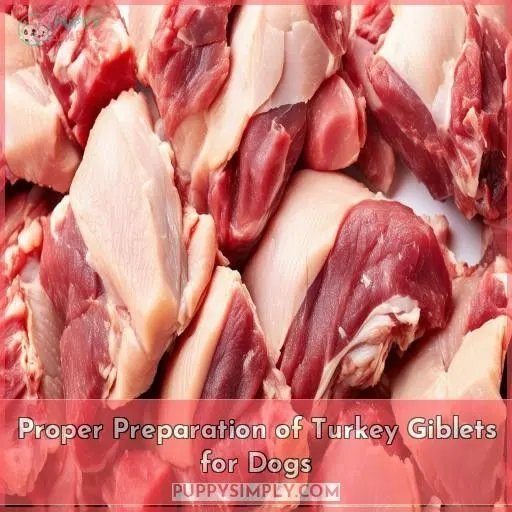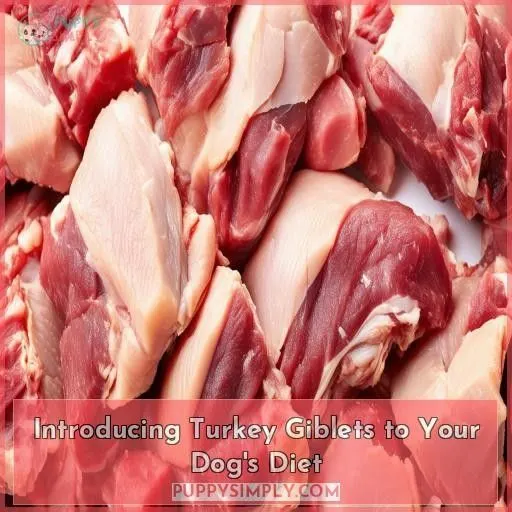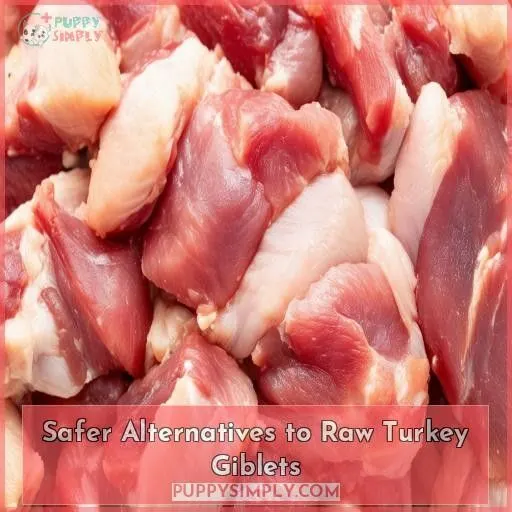This site is supported by our readers. We may earn a commission, at no cost to you, if you purchase through links.
 No, you shouldn’t feed your dog raw turkey giblets. While they’re packed with lean protein and essential nutrients, the risks far outweigh any benefits.
No, you shouldn’t feed your dog raw turkey giblets. While they’re packed with lean protein and essential nutrients, the risks far outweigh any benefits.
Raw giblets can harbor dangerous bacteria like salmonella, leading to severe digestive issues. Plus, those little organs—heart, liver, gizzard—are prime choking hazards or could cause intestinal blockages. It’s like giving your pup a ticking time bomb.
Instead, cook giblets thoroughly, remove any bones, and skip the seasonings. Or better yet, opt for safer alternatives like cooked turkey meat or specially formulated dog food.
Your furry friend’s health is at stake, so let’s not roll the dice with raw giblets. Stick around to uncover smarter ways to treat your pup.
Table Of Contents
Key Takeaways
- Hold your horses before tossing Fido those raw turkey giblets! They’re like a ticking time bomb for your pup, harboring nasty bacteria like salmonella that can lead to some serious tummy troubles. Trust me, you don’t want your living room turned into a doggy ER.
- Those tiny turkey organs might seem like the perfect bite-sized treat, but they’re more like a choking hazard in disguise. Hearts, livers, gizzards—they’re all prime suspects for getting stuck in your dog’s throat or causing an intestinal traffic jam. It’s not worth the risk, folks.
- I get it, you want to treat your furry friend to something special, but raw giblets are like playing nutritional Russian roulette. Instead, why not cook those giblets thoroughly, ditch any bones, and skip the seasonings? Or better yet, stick to safer options like cooked turkey meat or dog food—your pup will still wag their tail with joy.
- Remember, your dog’s health isn’t a game of chance. Before you start any turkey-venture, chat with your vet. They’re like the wise old sage of the pet world, offering tailored advice to keep your four-legged companion safe and happy. After all, it’s better to be safe than sorry when it comes to your best friend’s well-being.
Can Dogs Eat Giblets Raw?
No, dogs shouldn’t eat giblets raw. Raw giblets may contain harmful bacteria that can cause food poisoning in dogs, and the bones present a potential choking hazard.
Nutritional Value of Turkey Giblets for Dogs
Turkey giblets are a nutrient-dense source of lean protein and are rich in essential vitamins and minerals for dogs. While turkey giblets may be less inflammatory than chicken for some dogs, it’s essential to understand the potential risks and proper preparation methods before incorporating them into your pup’s diet.
Lean Protein
Turkey giblets are an excellent lean protein source, ideal for building and maintaining your dog’s muscle mass. The white meat is highly digestible, hypoallergenic, and lower in fat than chicken, making it perfect for weight management. With high-quality amino acids, turkey giblets nourish your furry friend without unnecessary calories.
Rich in Vitamins and Minerals
Turkey giblets offer more than just protein—they’re nutritional powerhouses! You’ll find they’re packed with essential vitamins and minerals that support your pup’s overall health:
- B Vitamins for energy metabolism
- Iron for oxygen transport
- Zinc for immune function
This nutrient density makes giblets a kibble-boosting treat.
May Be Less Inflammatory Than Chicken
What’s more, you may find that turkey is less inflammatory for your pup than chicken. Many dogs struggle with poultry allergies and inflammatory reactions, but turkey’s unique nutritional profile can be gentler on the gut and immune system. If your dog has gastrointestinal issues or chicken sensitivities, raw turkey giblets could provide a tasty alternative.
Risks of Feeding Raw Turkey Giblets to Dogs
Feeding raw turkey giblets to your dog poses significant risks, including bacterial contamination and digestive upset . Additionally, raw giblets can be a choking hazard, making it imperative to cook them thoroughly before serving.
Potential for Bacterial Contamination
Feeding raw turkey giblets to your dog poses potential risks, including bacterial infections like salmonella and E. coli. These bacteria can lead to severe health concerns, causing gastrointestinal upset. Unlike dark meat, raw giblets have a higher chance for contamination, which makes thorough cooking essential before serving to guarantee your dog’s safety and wellbeing.
Digestive Upset
Feeding raw turkey giblets to your dog can lead to digestive upset due to foodborne illnesses and gastrointestinal sensitivity. Raw giblets may harbor bacteria causing pancreatitis or worsening inflammatory bowel disease. Additionally, the risk of allergies increases. Opt for cooked turkey or turkey meal to avoid these health issues and guarantee safety .
Choking Hazard
When feeding raw turkey giblets to dogs, choking hazards can be significant. Raw turkey parts like the neck, heart, liver, kidney, and gizzard can cause issues such as:
- Esophageal blockage
- Intestinal obstruction
- Gastric torsion
- Tooth damage
Always supervise your dog while eating and prepare turkey parts properly to avoid these risks.
Proper Preparation of Turkey Giblets for Dogs
To prepare turkey giblets for your dog, cook them thoroughly to eliminate any harmful bacteria, and make certain there are no bones present to prevent choking hazards (Source). Avoid adding seasonings or gravies, as these can be harmful to your dog.
Cook Giblets Thoroughly
Cook giblets thoroughly before serving them to your dog. Boiling or baking guarantees they’re safe to eat and reduces the risk of bacterial contamination. Giblets as treats provide variety, support dental and joint health, and make excellent training rewards. Remember, avoid seasonings, turkey skin, or raw giblets to prevent environmental allergies and digestive issues .
Remove Any Bones
After cooking giblets thoroughly, removing any bones is essential for your dog’s safety. To do this:
- Identify and separate: Make sure no cooked turkey bones remain.
- Double-check: Feel the meat for hidden bones.
- Chop finely: Cut giblets into manageable, bone-free pieces.
- Serve safely: Mix with kibble or homemade dog food.
Avoid Seasonings and Gravies
When preparing turkey giblets for your dog, avoid seasonings and gravies. They can cause nausea, diarrhea, vomiting, and even dehydration. By keeping it simple, you guarantee your pet’s safety and well-being. Always opt for plain, cooked giblets without any garnishes.
| Seasoning Type | Risk | Symptom | Severity |
|---|---|---|---|
| Salt | Dehydration | Increased Thirst | High |
| Onion Powder | Toxicity | Vomiting | High |
| Garlic | Digestive Upset | Diarrhea | Medium |
| Gravy | Fatty Content | Nausea | Medium |
Introducing Turkey Giblets to Your Dog’s Diet
When introducing turkey giblets to your dog’s diet, start with small amounts to verify they tolerate it well. Always monitor for any allergic reactions and consult with your veterinarian for personalized advice (Source).
Start With Small Amounts
When starting to introduce turkey giblets to your dog’s diet, use portion control to avoid overfeeding. Here’s how:
- Begin with small amounts.
- Gradually increase the quantity over a week.
- Make sure the giblets are an appropriate size for your dog’s breed.
- Pause if any health concerns arise, consulting your vet if needed.
Monitor for Allergic Reactions
After introducing small amounts of turkey giblets, watch your dog closely.
Some pups may have allergic reactions, especially if they’re sensitive to chicken due to cross-reactivity. Signs include itching, hives, or digestive issues.
Don’t panic—every dog’s individual tolerance varies. If symptoms appear, stop feeding giblets and consider hypoallergenic alternatives like duck or venison for safe consumption.
Consult With Your Veterinarian
Before introducing turkey giblets to your dog’s diet, consult your veterinarian. They’re your pet’s health guardian, offering customized advice based on age, breed, and medical history.
A vet’s expertise ensures nutritional suitability, identifies potential risks, and provides safety precautions.
Think of them as your dog’s culinary guide, leading you through the giblet labyrinth to keep your furry friend safe and satisfied.
Safer Alternatives to Raw Turkey Giblets
While raw turkey giblets pose health risks, you have safer options like cooked turkey meat, turkey meal, and commercially prepared dog food. These alternatives offer similar nutritional benefits without the dangers associated with raw giblets, ensuring your dog’s safety and well-being.
Cooked Turkey Meat
While turkey giblets offer rich nutrition, raw ones pose risks.
Instead, opt for cooked turkey meat—a safer, equally nutritious alternative. It’s packed with lean protein and essential nutrients, potentially offering more health benefits than chicken.
Create a simple turkey giblet recipe by thoroughly cooking and dicing giblets, then mix with white meat. Store in airtight containers, refrigerated for up to three days.
Turkey Meal
While cooked turkey is safe, turkey meal offers a more convenient option. It’s a concentrated protein source made from ground, rendered turkey parts—including giblets—that are cooked, dried, and ground. Turkey meal ingredients often include:
- Cleaned giblets (safe when properly processed)
- White and dark meat
- Bones (ground for calcium)
- Cartilage (for joint health)
-
Organ meats (nutrient-rich)
This meal nutrition powerhouse requires no preparation or special storage, making it a worry-free choice for your pup’s safety and well-being.
Commercially Prepared Dog Food
You’re not alone in wanting to keep your furry friend safe. Many dog food brands offer balanced diets that include turkey, minus the risks. Commercial kibble often contains turkey meal, a safer alternative to raw giblets. For a personal touch, try homemade treats with cooked turkey meat. Either way, you’re ensuring your pup’s pet nutrition needs are met without compromise.
Frequently Asked Questions (FAQs)
Can dogs with sensitive stomachs tolerate turkey giblets?
You’ll want to tread carefully with turkey giblets if your dog has a sensitive stomach. Cooked thoroughly, they’re nutrient-rich and often well-tolerated, but introduce them gradually. Monitor your pup closely for any signs of discomfort—safety first, always.
How much raw turkey giblet should I feed daily?
Beware: Raw turkey giblets can harbor harmful bacteria. It’s imperative to cook them thoroughly. Even then, feed sparingly—no more than a tablespoon per 20 pounds of your dog’s weight daily, gradually introducing them to avoid digestive upset.
Are turkey giblets better than chicken giblets for dogs?
You’re better off with turkey giblets for your pup. They’re leaner and may be easier on sensitive tummies. But don’t serve them raw—cook thoroughly to kill harmful bacteria. Always introduce new foods gradually to watch for allergies.
Can puppies eat turkey giblets, or only adult dogs?
Imagine your puppy as a tiny turkey inspector, intently eyeing those giblets. Hold up! While both puppies and adults can enjoy cooked turkey giblets, raw ones are off-limits. They’re potential bacteria bombs that could upset your pup’s delicate digestive system.
Do turkey giblets help with my dogs joint health?
No, turkey giblets won’t directly boost your dog’s joint health. They’re protein-rich but lack glucosamine and chondroitin, key for joints. For that, you’ll want supplements or foods like green-lipped mussels. Always cook giblets thoroughly to guarantee safety.
Conclusion
Ultimately, raw turkey giblets are like a Trojan horse—seemingly harmless, yet hiding potential dangers. You shouldn’t feed your dog raw giblets, as they pose serious health risks: bacterial contamination, digestive issues, and choking hazards.
Instead, opt for safer alternatives like cooked turkey meat or specially formulated dog food. If you’re set on giblets, cook them thoroughly, remove bones, and skip seasonings.
Always consult your vet before introducing new foods. Your dog’s health isn’t a game of chance—make informed choices to keep your furry friend safe.

